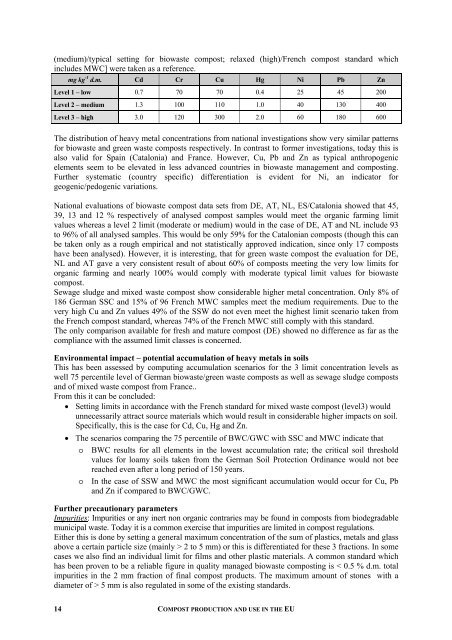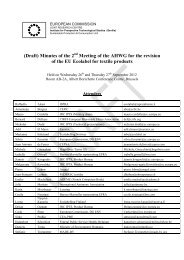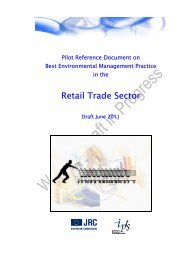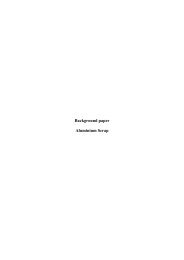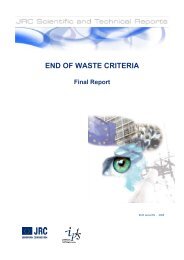final report - JRC IPTS - Sustainable Production and Consumption ...
final report - JRC IPTS - Sustainable Production and Consumption ...
final report - JRC IPTS - Sustainable Production and Consumption ...
Create successful ePaper yourself
Turn your PDF publications into a flip-book with our unique Google optimized e-Paper software.
(medium)/typical setting for biowaste compost; relaxed (high)/French compost st<strong>and</strong>ard which<br />
includes MWC] were taken as a reference.<br />
mg kg -1 d.m. Cd Cr Cu Hg Ni Pb Zn<br />
Level 1 – low 0.7 70 70 0.4 25 45 200<br />
Level 2 – medium 1.3 100 110 1.0 40 130 400<br />
Level 3 – high 3.0 120 300 2.0 60 180 600<br />
The distribution of heavy metal concentrations from national investigations show very similar patterns<br />
for biowaste <strong>and</strong> green waste composts respectively. In contrast to former investigations, today this is<br />
also valid for Spain (Catalonia) <strong>and</strong> France. However, Cu, Pb <strong>and</strong> Zn as typical anthropogenic<br />
elements seem to be elevated in less advanced countries in biowaste management <strong>and</strong> composting.<br />
Further systematic (country specific) differentiation is evident for Ni, an indicator for<br />
geogenic/pedogenic variations.<br />
National evaluations of biowaste compost data sets from DE, AT, NL, ES/Catalonia showed that 45,<br />
39, 13 <strong>and</strong> 12 % respectively of analysed compost samples would meet the organic farming limit<br />
values whereas a level 2 limit (moderate or medium) would in the case of DE, AT <strong>and</strong> NL include 93<br />
to 96% of all analysed samples. This would be only 59% for the Catalonian composts (though this can<br />
be taken only as a rough empirical <strong>and</strong> not statistically approved indication, since only 17 composts<br />
have been analysed). However, it is interesting, that for green waste compost the evaluation for DE,<br />
NL <strong>and</strong> AT gave a very consistent result of about 60% of composts meeting the very low limits for<br />
organic farming <strong>and</strong> nearly 100% would comply with moderate typical limit values for biowaste<br />
compost.<br />
Sewage sludge <strong>and</strong> mixed waste compost show considerable higher metal concentration. Only 8% of<br />
186 German SSC <strong>and</strong> 15% of 96 French MWC samples meet the medium requirements. Due to the<br />
very high Cu <strong>and</strong> Zn values 49% of the SSW do not even meet the highest limit scenario taken from<br />
the French compost st<strong>and</strong>ard, whereas 74% of the French MWC still comply with this st<strong>and</strong>ard.<br />
The only comparison available for fresh <strong>and</strong> mature compost (DE) showed no difference as far as the<br />
compliance with the assumed limit classes is concerned.<br />
Environmental impact – potential accumulation of heavy metals in soils<br />
This has been assessed by computing accumulation scenarios for the 3 limit concentration levels as<br />
well 75 percentile level of German biowaste/green waste composts as well as sewage sludge composts<br />
<strong>and</strong> of mixed waste compost from France..<br />
From this it can be concluded:<br />
• Setting limits in accordance with the French st<strong>and</strong>ard for mixed waste compost (level3) would<br />
unnecessarily attract source materials which would result in considerable higher impacts on soil.<br />
Specifically, this is the case for Cd, Cu, Hg <strong>and</strong> Zn.<br />
• The scenarios comparing the 75 percentile of BWC/GWC with SSC <strong>and</strong> MWC indicate that<br />
o BWC results for all elements in the lowest accumulation rate; the critical soil threshold<br />
values for loamy soils taken from the German Soil Protection Ordinance would not bee<br />
reached even after a long period of 150 years.<br />
o In the case of SSW <strong>and</strong> MWC the most significant accumulation would occur for Cu, Pb<br />
<strong>and</strong> Zn if compared to BWC/GWC.<br />
Further precautionary parameters<br />
Impurities: Impurities or any inert non organic contraries may be found in composts from biodegradable<br />
municipal waste. Today it is a common exercise that impurities are limited in compost regulations.<br />
Either this is done by setting a general maximum concentration of the sum of plastics, metals <strong>and</strong> glass<br />
above a certain particle size (mainly > 2 to 5 mm) or this is differentiated for these 3 fractions. In some<br />
cases we also find an individual limit for films <strong>and</strong> other plastic materials. A common st<strong>and</strong>ard which<br />
has been proven to be a reliable figure in quality managed biowaste composting is < 0.5 % d.m. total<br />
impurities in the 2 mm fraction of <strong>final</strong> compost products. The maximum amount of stones with a<br />
diameter of > 5 mm is also regulated in some of the existing st<strong>and</strong>ards.<br />
14<br />
COMPOST PRODUCTION AND USE IN THE EU


